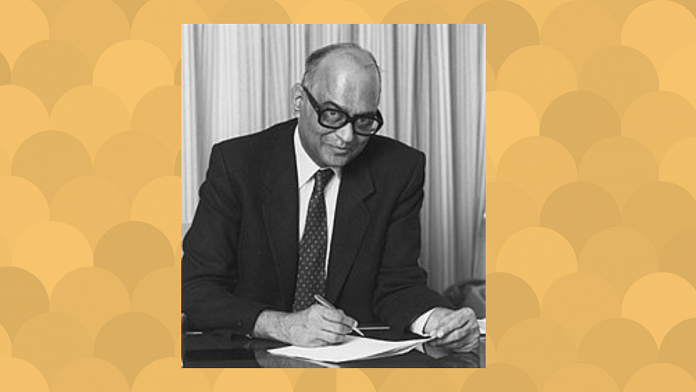Patel was the first Indian director of London School of Economics, and worked with four Indian PMs — Nehru, Shastri, Indira Gandhi and Morarji Desai.
New Delhi: Noted economist Indraprasad Gordhanbhai Patel, the first Gujarati to head the Reserve Bank of India, is better known for his caustic remarks against the demonetisation decision of the Morarji Desai government.
It is said that Patel had told then PM Desai that demonetisation would not work.
Patel was also the first Indian to hold the office of director at the London School of Economics.
On his 94th birth anniversary, ThePrint looks back on his life and the reforms that he ushered in at India’s central bank.
Also read: VT Krishnamachari: India’s master planner who laid the foundation of panchayati raj system
Early life
Born to Gordhanbhai Patel and Kashiben Patel on 11 November 1924 in Vadodara in Gujarat, Indraprasad was a very bright student; he stood first in the matriculation examinations. After securing a bachelor’s degree in economics from Bombay University, he went on to pursue his doctorate from King’s College, London with a scholarship funded by the Gaekwad ruler in Vadodara. In fact, his professor at Cambridge — Austin Robinson — a close aide of renowned economist John Meynard Keynes, regarded him as his best student.
Patel came back to Bombay (now Mumbai) to serve his alma mater. After a brief tenure at University of Bombay as professor of economics, he joined the research department of the International Monetary Fund (IMF) in 1948 under its first director Dr Edward Bernstein, who would later become his mentor and co-author of the famous ‘Bernstein report on India: Economic Development with Stability’. In 1958, he got married to Alaknanda Dasgupta, the daughter of famous economist A.K. Dasgupta.
Also read: Hiralal Shastri, the man who pushed for equal rights within Constituent Assembly
Tenure at finance ministry
In 1954, he returned to India to work as an adviser to the then finance minister C.D. Deshmukh. For the next two decades, Patel would become one of the key persons in the administration. He was one of the architects of the first few five-year plans, besides economic policies. He worked with four PMs – Jawaharlal Nehru, Lal Bahadur Shastri, Indira Gandhi, and Moraji Desai.
Economist Deepak Lal wrote that Patel tried to strike a balance between the planning commission members toeing the socialist line of the erstwhile Soviet Union and those in the finance ministry who were “concerned with the inflationary impact of the planners’ emphasis on heavy industry”.
When Nehru died in 1964, Patel wrote on Economic and Political Weekly magazine about ‘The Socialist legacy’ that he left behind.
In 1969, when Indira Gandhi took over the finance portfolio from Moraji Desai, it was the then secretary, economic affairs I.G. Patel who helped her comprehend the economic problems of the country.
In fact, he wrote the 1969 budget speech for Mrs Gandhi. During the 1971 war when Gandhi was skeptical about whether India can handle the situation if America went with Pakistan, Patel, the then principal secretary in the finance ministry, was believed to have told Mrs Gandhi that India could survive for five to six months with the thousand crore foreign exchange reserves and foodgrain in granaries.
Also read: Demonetisation — from place of pride to albatross around the BJP’s neck
RBI governor and 1978 demonetisation
In a short stint, Patel also served as deputy administrator of UNDP from 1972 to 1977. Following this, Patel was appointed the governor of the Reserve Bank of India. It was the time when India witnessed its second demonetisation.
When the Janata government in 1978 took the demonetisation decision to eliminate black money and illegal transactions in the post-Emergency phase, I.G. Patel expressed his concerns over the move but his views were not taken seriously.
“Thinking that black money is stashed away under mattresses or suitcases is naive,” he wrote to the then finance minister H.M. Patel.
After Patel, Dr Manmohan Singh took over as RBI governor in 1982.
Return to academia
Patel was appointed the principal of Indian Institute of Management, Ahmedabad (IIM-A) in 1982. He played a significant role in turning IIM-A into a world-class B-school it is today.
In 1984, Patel became the director of the prestigious London School of Economics (LSE) and became the first Indian to head any educational institution in the United Kingdom. He wrote the book, Glimpses of Indian Economic Policy: An Insider’s View (2002) on his episode with the Indian economy.
He was awarded the Padma Vibhushan in 1991 for his contributions to the field of economics. Patel died in New York at the age of 80, on July 17, 2005.




Great man. He was offered the FM’s post in 1991 but declined, perhaps due to health reasons, giving Dr Singh a career altering opportunity.